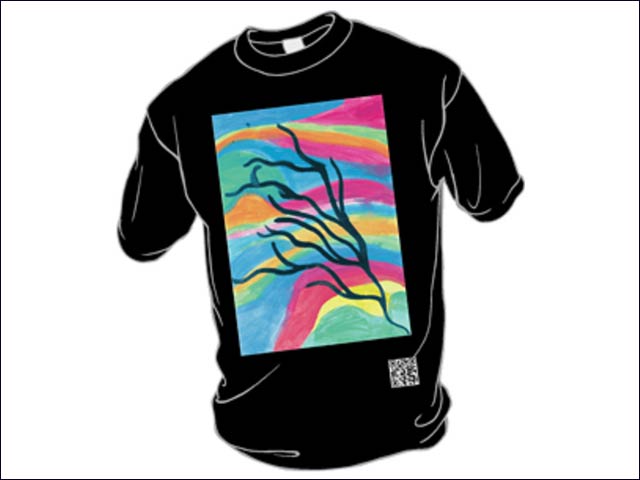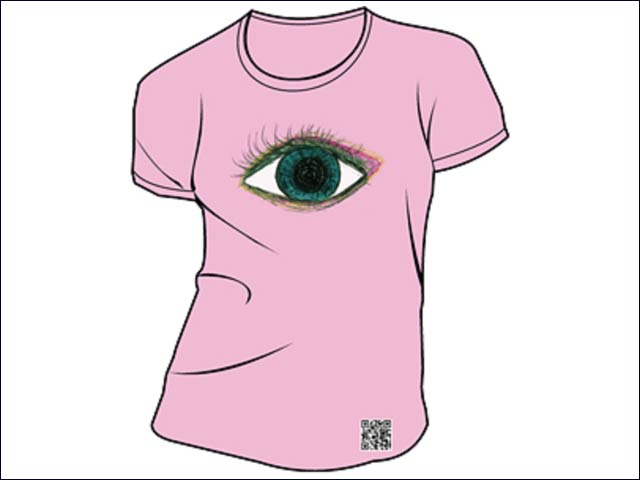By Avigayil Kadesh
Scan the QR barcode on the Tees at Risk “Bolt” style, and you’ll find out this story behind the shirt’s artwork:
“My name is D. I am a 16 year old boy. I ran away from home for the first time when I was 13 because my dad had a drinking problem and it was too violent. I spend some of my time in a juvenile detention center because I cut school with some friends and we got into serious trouble with the police. This picture shows how I feel when I'm at the detention center and my hope for something better in my life.”

“Bolt”It was for teenagers like D. that two American transplants in Israel started Tees at Risk in 2011. The idea is simple yet innovative: Invite troubled or disadvantaged youths to design t-shirt art, and then sell the garments for $25 apiece to benefit the very institutions that help these teens.
Even more innovative, Tees at Risk is neither a for-profit nor a non-profit entity. It is the only apparel company in the 600-plus list of certified B Corporations, which uses the power of business to solve social and environmental problems. B Corporations pledge to give away a certain percentage of the sales price (in this case, 10 percent) to charity.
Co-founder Ben Wiener, 42, explains that he and his friend Richard (Nahum) Kligman share an interest in helping troubled teenagers succeed in life. Kligman worked with an Israeli rehab program for girls, while Wiener is a board member of the Orthodox Union, which sponsors the Zula, a downtown Jerusalem drop-in center and program for teens involved in drugs, alcohol and promiscuity.
Cycle of benefit
“Nahum had the idea to make t-shirts designed by the kids, because self-confidence is a tremendous issue for this population. To take something they created and make a product out of it is an incredible boost,” says Wiener, a corporate lawyer in Manhattan before moving to Jerusalem in 1998 and refocusing his energies on business and charitable endeavors.
“Then we added the element of creating a cycle of benefit. If a kid from the Zula creates a design, it benefits the Zula while that kid is still part of it.”
The other two current beneficiaries are the National Runaway Switchboard, based in Chicago, and NY Youth at Risk.
“In almost any major city in the world, there are drop-in centers where these kids end up, and many of these centers have an art room and/or an art counselor. We let these centers know we have this project, and they can upload artwork digitally. If we pick a design from that center, we’ll produce the shirt and send them some of the proceeds.”
Working with a fashion executive in New York, the partners initially chose three designs to screen-print on all-cotton shirts, made in California and shipped everywhere. One of the designs, “Eye,” features a drawing by a young woman who had been kicked out of her house at 17.

“Eye”“She couldn’t believe we’d picked her drawing and told me she intended to rebuild her life by going to fashion design school and wanted to use it as part of her portfolio,” relates Wiener.
“I said she could also use us as a reference. A kid literally on the street suddenly gets a rush of self-esteem, the shirt benefits the institution that helped her get on her feet, and now it may help her get into school and get her life on track. That’s pretty incredible.”
Tees at Risk on London’s Downing Street
Wiener and Kligman are looking for the widest possible exposure for Tees at Risk. Country music star Jimmy Wayne tweeted a photo of one of the shirts and said he’d wear it at a concert. And the shirts got a glowing review by an MTV blogger.
In 2012, the coordinator of “digi steps,” a volunteer organization based at the Avonbourne School in southern England, found Tees at Risk online and ordered a special custom run. These shirts are now worn by students teaching senior citizens how to use computers and the Internet.
They also wore their Tees at Risk shirts to an award ceremony at the prime minister’s residence at 10 Downing Street. Last summer they received yet another award and wore their shirts proudly.
“We decided to give the proceeds from our digi steps design commission to the Youth for Technology Foundation, a nonprofit that teaches technology to underprivileged kids in Africa,” says Wiener. “We thought that would be a great way to bring the work of digi steps full circle – from kids teaching the elderly how to use the Net, to helping underprivileged kids learn how to use the Net.”
A QR barcode printed on each shirt can be scanned using a data-enabled iPhone or Android smartphone.
“It literally tells the story, written by the kid who designed the shirt, and links to the charity being supported by the shirt,” says Wiener. “We’re implanting cool technology to advance the cause.”
Both men run other businesses and view Tees at Risk as a hobby project.
“I would love for it to be a million-dollar company but I don’t expect it to be our profession,” Wiener says. “It’s a test of the concept of giving back. We just want to affect as many lives as we can and promote awareness of teens at risk and showcase how talented they are. We want to give them support and hope, rather than give up on them.”